The scale length of a guitar refers to the vibrating length of the strings. It’s one of the most important factors affecting the feel, tone and how the guitar plays.
Understanding guitar scale length is essential whether you’re a beginner buying your first guitar or an experienced player doing a setup. The distance between the nut and bridge has a noticeable effect on how a guitar feels to play and the tones it can produce.
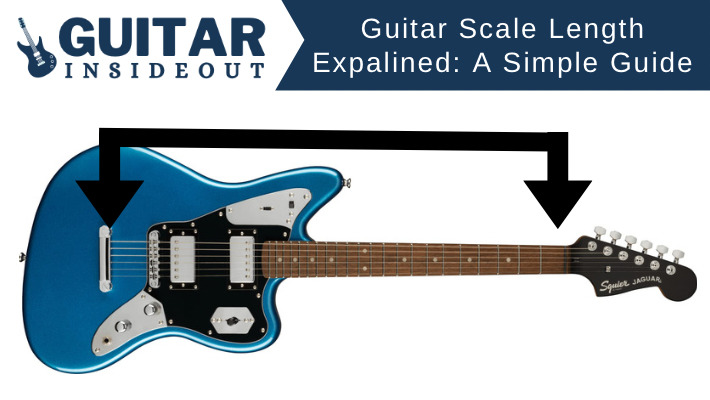
In this guide I’ll explain everything you need to know about scale length – from what it is and how it’s measured to the impact it has on string tension, fret spacing, action, sound and more.
What is Guitar Scale Length?
The scale length of a guitar is the distance between the nut (where the strings pass over the neck) and the bridge saddles (where the strings end and transfer vibration to the bridge).
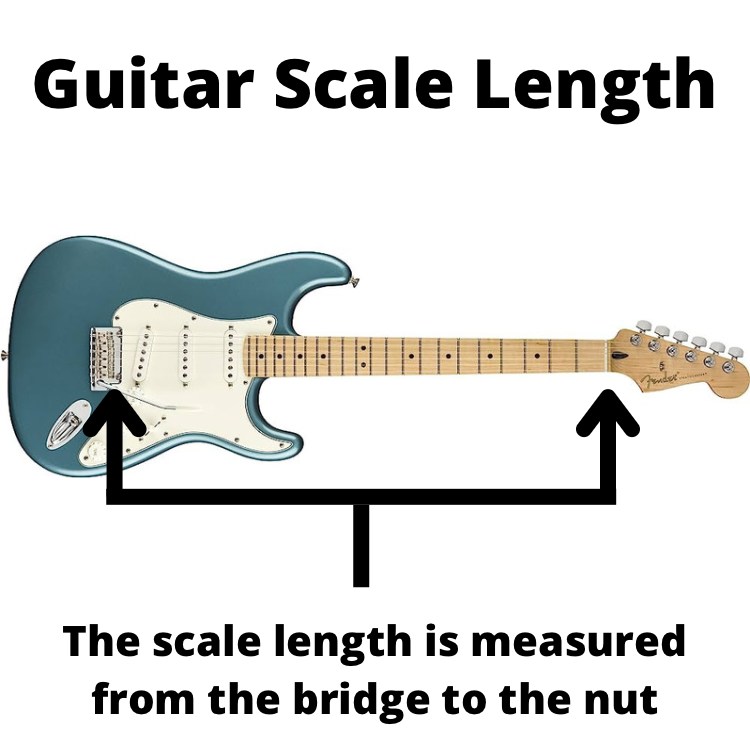
This effective vibrating length determines the fundamental pitch of each string when played open.
Scale length is measured in inches or millimeters along the playing surface of the strings. You measure it from the nut to bridge saddle for each string. It can vary significantly between different guitar types and models.
Some of the more popular electric guitar scale lengths are:
- 22”-24” (559-610mm) – Extra short scale student and travel guitars
- 24” (610mm) – Fender Jaguar, Fender Mustang
- 24.5” (622mm) – PRS Santana Signature Models
- 24.75” (628mm) – Gibson, Epiphone
- 25” (635mm) – Most PRS, Carvin, Danelectro
- 25.5” (648mm) – Fender, Squier, Ibanez, Jackson, Schecter
- 26.5”-27” (673-686mm) – Extended Range 7/8 string guitars
- 27”+ (686mm+) – Baritone guitars and extended range 9 string models
Generally the longer the scale length the higher the string tension required to reach standard tuning pitch. So shorter scale length guitars need less overall tension compared to long scales on the same gauge strings.
These different lengths have a big impact on the feel, tone and how the guitar plays.
How Scale Length is Measured on a Guitar
While it may seem you could just measure directly from the nut to the bridge to get the scale length this doesn’t account for the saddle intonation adjustment at the bridge. Guitar saddles are set back slightly further for the lower wound strings. This means when they’re fretted they vibrate in tune at the 12th fret and beyond.
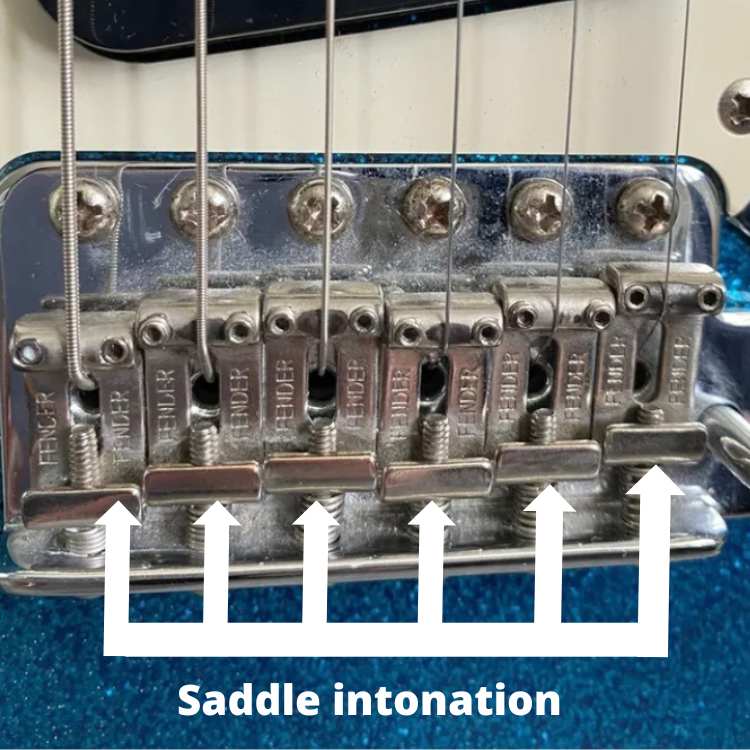
So because of this the accurate way to measure a guitar’s scale length is to take the distance from the nut to the 12th fret and then multiply that by two. This compensates for the saddle intonation.
Using a Fender Stratocaster as an example – measure from the nut to the 12th fret might give you a reading of 12 3/4 inches. Doubling this measurement gives you 25.5 inches, which is the correct scale length for a Strat.
Measuring each string’s scale length individually also accounts for any small variances in saddle position. So you end up with most precise scale length measurement possible.
The Effects of Scale Length on How a Guitar Plays
Now that we understand exactly what scale length is and how to measure it it’s worth looking at how much it affects the way a guitar feels and plays.
Scale Length Affects String Tension
The most noticeable effect that scale length has on a guitar is the tension of the strings. As we went over earlier, longer scale lengths require higher string tension to reach standard tuning when compared to shorter scale lengths using the same string gauge.
This difference in tension has a big impact on the feel and playability of the guitar. Having higher tension on long scale guitar means string bends and vibrato require more effort and strength. But this also means the strings hold tune better, especially when playing with an aggressive technique or when tuning low.
On the other hand the lower tension on short scale guitars provides a looser string feel and allows for easier bending, vibrato and fretting in standard tuning. But the strings can feel ‘floppy’ when tuning down low. In fact you may struggle to tune low and play without any issues on short scale guitar.
This is why baritone guitars with their ultralong 27”-30” scale lengths feel so tight and responsive – the high tension allows stable tuning even when you’ve dropped to something extreme like Drop A, or lower. In that case though doing vibrato or standard bends requires a lot more finger strength.
Scale Length Alters Fret Spacing
The scale length of a guitar also changes the spacing between frets along the neck. Longer scale guitars have wider fret spacing. Shorter scale guitars feel more cramped along the neck with smaller gaps between notes.
For example a 24” scale length Fender Mustang has 1 1/4” spacing between the nut and first fret. Compare this to a 27” baritone guitar which has a 1 1/2” first fret spacing. A big difference.
Wider fret spacing may suits guitarists with larger hands and longer fingers. And those with smaller hands, like myself, often feel more comfortable with the tighter fret spacing on shorter scale guitars.
Having said that I play regular scale length Telecaster as my main guitar. And honestly, I’m fine with it.
I do notice the difference with shorter scale guitars. But it’s not enough of a difference to make me want to avoid regular scale lengths. If you’ve got smaller hands or fingers then it’s worth trying lots of different scale lengths to see if you prefer one or another.
Dramatic differences in guitar scale lengths like 24” vs 27” will significantly change not just the feel but also the accessibility of the fretboard. But subtle 1” differences between common 25” and 26” scale guitars have a much more gradual impact on fret spacing.
Scale Length Impacts Action
The scale length can also affect the action of the guitar. Or at least where you need to set the action in order for it to play properly.
Guitars with short scale lengths and lower string tension allow the strings to vibrate more freely. But with the greater vibration you it can potentially require higher action to avoid fret buzz and rattling.
No surprise then that the opposite is true. So having higher string tension you get on longer scale guitars allows the action to be set much lower without the strings buzzing. The upside of this is it can make fretting notes and chords easier on a long scale guitar.
How you get around this is by adjusting the string gauge you use. By trying different gauge strings you can tweak the tension and optimize action regardless of scale length. For example increasing gauge on a short scale guitar raises tension allowing lower action to prevent buzz.
Scale Length Affects Tone
That’s right, the scale length will directly affect the tone of the guitar. The different scale lengths change how the strings vibrate and the tension of them.
Longer scale length means the strings are under greater tension to reach the same pitch when compared to shorter scale lengths. The higher tension makes the strings sound brighter.
There’s also the vibration of the strings. A longer scale length means the strings vibrate more. This gives a full sound. Shorter scale lengths produce a warmer and softer tone.
For example the classic Gibson Les Paul scale length of 24.75” contributes to its signature thick, warm humbucker tone. While the 25.5” Fender Stratocaster scale has a brighter and crisper tone that it’s known for.
Matching Scale Length and String Gauge
Getting the best string gauge for your guitar and scale length is important. Choosing the right string gauge lets you tailor the feel and tension to suit your style.
Heavier string gauges can be used to increase the tension on short scale guitars. This will provide better and more stable tuning as well as a tighter playing feel that’s similar to longer scale length guitars.
Lighter string gauges will reduce tension on long scale guitars. This should make bends easier without compromising the tone that scale length provides.
Matching the gauge of string to your scale length gives you the best of both worlds. Short scale guitars can get great tuning stability with heavier strings while long scale lengths get comfortable playability using lighter strings.
Be aware though, there are always tradeoffs whenever significantly altering string gauge relative to scale length.
Heavier gauges on short scales do improve the clarity but will reduce the warmth and thickness of the tone. And on the other side lighter gauges on longer scales will make them play easier but can lose some tightness and definition on the low end.
This is where multi-scale and fanned fret guitars help! They can deal with the compromises of tuning standard straight scale guitars.
Multiscale and Fanned Fret Guitars
Multiscale guitars or fanned fret guitars are designed to give you the ideal scale length and tension for each string by angling the frets to create a fanned effect. This results in tapered scale lengths across the neck.
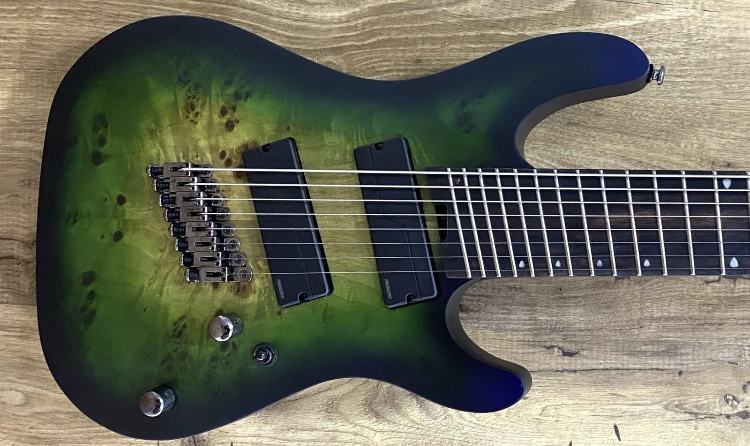
Typically the lowest strings have an extended scale length – eg 27”-28” to provide tight defined bass tones. The higher strings have a shorter 24”-25.5” scale allowing comfortable playing of bends and vibrato.
This means every string has its optimum scale length and matched tension, rather than forcing a single scale length and tension compromise across all strings.
While less common on 6 string guitars, multi-scale fretboards are popular on 7 and 8 string guitars. The extra tension control helps balance the feel across the wide tuning range these instruments provide.
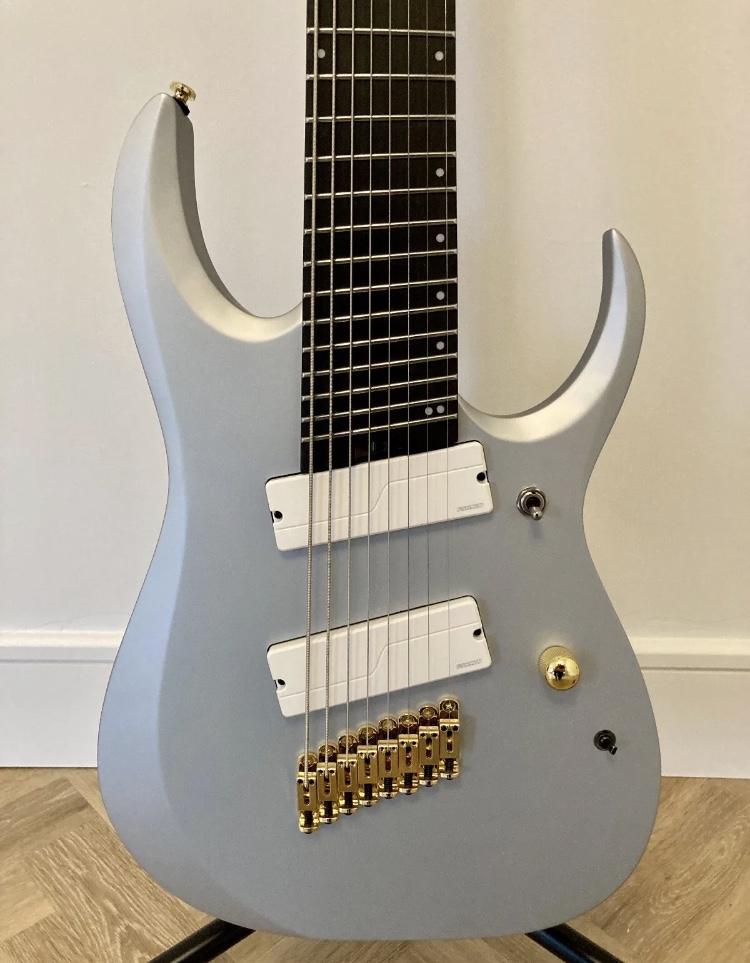
Choosing the Right Scale Length for Your Needs
When selecting your ideal guitar the scale length should be a consideration. Maybe not the number one factor but definitely something of think about it.
What should come before scale length are your playing style, preferred musical genres, tuning preferences etc. But what you will find is that those will guide your scale length decision.
For example if you’re playing lead then you will probably prioritize a faster neck, the ability to do long bends and lots of vibrato. That means a shorter 24”-25” scale length will likely be best.
Whereas rhythm guitarists who are all about the riffs and maybe lower tunings are going to be happier with longer scale lengths – 25.5”-27”.
What’s important though is to try guitars with different scale lengths. Going through a lot of different lengths will help you to find what truly fits your hands.
Extreme scales like 22” and 27” will drastically change the playing feel compared to 24”-25.5” guitars. But between popular scales like 25” and 25.5”, the difference may be more subtle depending on your hands size and finger length.
Conclusion
A guitar’s scale length has a big influence on how it feels, plays and the tone you can get from it. While it may seem complicated on paper it’s really not that tricky to understand.
It all comes down to tension. Longer scale lengths require higher tension for standard tuning stability, which impacts everything from the ease of bending strings to the harmonic character.
So choosing the right scale length for your playing style, technique and the sound you want is a big deal. Hopefully you now have a better understanding of scale lengths and can now make the bets choice for your needs.
Great article! Helped in my current guitar search. Thanks!
Glad it helped!